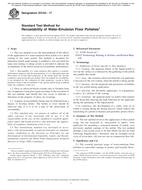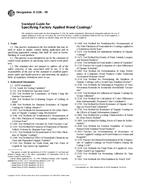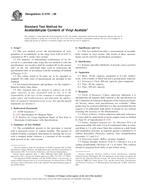1.1 This test method is for the determination of the weight percent of individual volatile organic compounds in air-dry coatings.
1.2 The method can be used to determine the weight fraction VOC content of waterborne coatings in which the material VOC content is below 5 weight percent. The method has been used successfully with higher VOC content waterborne coatings and with solvent-borne coatings (Note 1).
1.3 The method may also be used to measure the exempt volatile organic compound content (acetone, methyl acetate, t-butyl acetate and p-chlorobezotrifluoride) of waterborne and solvent-borne coatings. The methodology is virtually identical to that used in Test Method D6133 which, as written, is specific for only exempt volatile compounds.
1.4 Volatile compounds that are present at the 0.005 weight percent level or greater can be determined.
Note 1 – This test method may be used for the VOC analysis of coatings containing silanes, siloxanes, and silane-siloxane blends. The test method is not suitable for the analysis of coatings that cure by chemical reaction (this includes two-component coatings and coatings which cure when heated) because dilution with a solvent would impede the chemical reaction required for these types of coatings. This test method measures the VOC weight fraction of air-dry coatings directly as opposed to the methods of Practice D3960 which measure the VOC weight fraction of air-dry waterborne coatings indirectly. A direct measurement of VOC weight fraction, particularly in low VOC content waterborne coatings, generally gives better precision. California Polytechnic State University carried out an extensive study for the California Air Resources Board comparing the precision of the direct method with the indirect method (CARB Standard Agreement No. 04.329). This study may be used to decide if the present method or the methods of Practice D3960 are preferred as an analysis method for obtaining the best possible precision for measuring the mass-based VOC content of a specific coating.
1.5 The values stated in SI units are to be regarded as standard. No other units of measurement are included in this standard.
1.6 This standard does not purport to address all of the safety concerns, if any, associated with its use. It is the responsibility of the user of this standard to establish appropriate safety and health practices and determine the applicability of regulatory limitations prior to use.
Product Details
- Published:
- 05/01/2012
- Number of Pages:
- 7
- File Size:
- 1 file , 100 KB
- Redline File Size:
- 2 files , 210 KB


